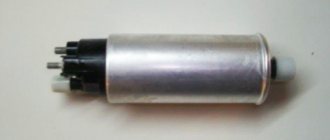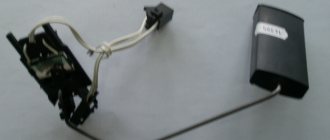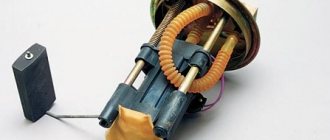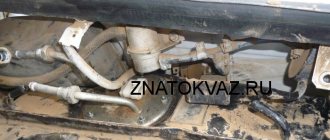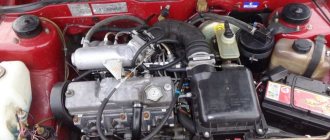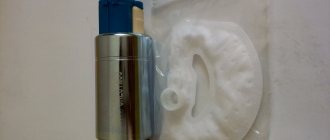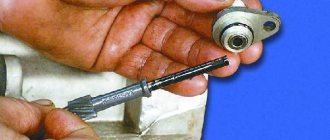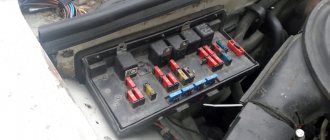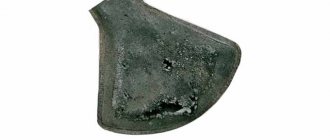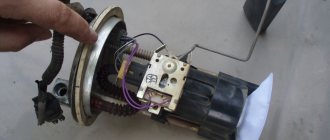The gasoline pump in the fuel system of a carburetor engine is responsible for the uninterrupted supply of fuel from the fuel tank to the carburetor. Accordingly, the main signs that indicate a malfunction in its operation are associated with a deterioration in fuel supply, which in turn can manifest itself either in poor starting of a cold engine, the appearance of interruptions during its operation at different crankshaft speeds, etc. Before proceeding with disassembly and repair, it is necessary to check the fuel pump, and to do this we will perform the following sequence of actions:
• Loosen the fastening clamp and remove the hose from the pump discharge pipe. The discharge pipe is the one that is located closer to the carburetor in the direction of fuel supply in the line. • After removing the hose, start pumping the fuel pump handle. The fuel pump handle only works at a certain position of the crankshaft, so if the pump does not pump, try turning the crankshaft half a turn and try again. Fuel under pressure must be supplied through the pipe. If the fuel stream is weak or does not flow at all, loosen the clamp and remove the hose from the suction pipe.
• Close the suction pipe with your finger and pump the fuel pump. A vacuum should be created in the pipe, which you can feel with your fingertip. If a vacuum is not created, then it is necessary to remove and repair the fuel pump or completely replace it with a new one.
If the fuel pump on a VAZ 2109 malfunctions, the fuel supply to the carburetor is completely or partially stopped. Therefore, it is not possible to start the engine cold or hot. It will start at first, but then immediately die. Plus, instability at idle is often observed.
Before changing the fuel pump, it is recommended to first check the condition of the device. It is not uncommon for a breakdown to be corrected with minor repairs.
Checking and adjusting pump pressure
It's no secret that any car part has a certain resource. So the “nine” fuel pump, like any part, eventually stops pumping gasoline properly, our instructions will help you figure it out:
- Moreover, on the VAZ 2109 the problems with the fuel pump are always the same
- As a rule, the reasons are not tightness of the valves or housing, fuel wire, or diaphragm, perhaps the fuel filters are clogged, or the fuel supply lines are overheating
- The main problem is ultimately insufficient gasoline pressure at the outlet of the fuel pump.
- And in the case when your fuel pump initially could not show the appropriate (required) output pressure, then all the problems stated above only aggravate the situation
- You need to know exactly the output pressure (immediately before the carburetor) that the fuel pump should develop when the engine is idling.
- As a rule, all fuel pumps - both cars and trucks - must produce a pressure in the range from 0.20 atmospheres to 0.35 atmospheres. When your gas pump has a similar output pressure, then you should not have problems with gasoline supply
- The pressure is measured with a pressure gauge that has a scale with divisions of 1.6 atmospheres - on such a pressure gauge it will be possible to record the pressure of the fuel pump
- When the pressure is measured and it turns out to be below normal, you may just need to adjust the pump
- It is possible to adjust the fuel pump either by moving it closer or further from the engine block (by changing the thickness of the gasket)
- The second method is to strengthen the spring (washers are placed under it, the operation is performed taking into account the wear of existing parts and the strength of the spring)
- The third option is to change the length of the rod
- Any of the listed measures (or all in combination) make it possible to increase the pressure of the fuel pump to the level of 0.20 - 0.30 atmospheres
- The best thing, of course, is to bring the figure to 0.30-0.35 atmospheres at idle speed
- When the engine starts running at higher speeds, this figure will increase a little more.
Characteristics of the VAZ 2109 fuel pump
To understand how a working pump works and check its operation, it is important to know its operating characteristics:
- The length of its rod is 82.4 millimeters
- In this case, the rod protrudes above the gasket by 0.8 - 1.3 millimeters
- The thickness of the very first gasket is 0.3 millimeters
- And, the stroke of the rod is 2.5 - 2.8 millimeters
Useful tips
A couple of very useful recommendations for beginners on what to do if a fuel pump malfunction occurs on a VAZ 2109:
It is important to note that on machines that have a return line, the problem may arise due to the release hole being too large, then most of the pressure is relieved by the return line. In the event that the installed pump on your machine cannot be adjusted, you will have to replace it Today on the market Dozens of models of pumps for VAZ from different manufacturers are sold. In order not to buy a fake, you should approach the purchase very responsibly - choose a company store and a reputable manufacturing company, purchase exclusively models of gasoline pumps recommended by the VAZ plant. And the most ideal option is to contact an official dealer of VAZ spare parts in in your region, then you will receive the required part quickly, and you won’t worry about whether you got a bad quality fuel pump, and you won’t have to look for and buy a new pump a second time
The fuel pump does not work, the relay turns on.
Checking relay power.
In the case when the fuel pump relay turns on when the ignition is turned on, but the pump itself does not work, you need to check the power at terminal 87 of the fuel pump relay. To do this, touch terminal 87 of the relay socket with the output of the control lamp connected to the vehicle ground, and the lamp should light up. If the lamp does not light, it means the fuse has blown or there is a break in the wire.
If there is power at terminal 87, you should remove the relay from the socket, and instead place a jumper between pins 87 and 30. In this case, if the pump and connecting wires are working properly, the pump should start working and if this happens, the relay should be changed. If the pump does not start working, then, without removing the jumper, you need to touch the power wire on the fuel pump with a test lamp connected to the vehicle ground.
Checking the fuel pump power circuit.
If a submersible pump is installed on the car as part of the fuel module, you need to remove the connecting connector and touch one of the thick wires. When you touch one of them, the indicator lamp should light up. If the lamp does not light up on any of the wires, then it is necessary to eliminate the break in the wire from the fuel pump relay to the module connector or the pump itself, if the pump is of a remote type. One of the reasons for the break may be the anti-theft blocking of an installed non-standard alarm system.
Disassembling and replacing the fuel pump
So, now we’ll tell you specifically about how to properly disassemble, replace damaged elements of the fuel pump, or completely replace this device with a new one.
Hatch
- In any case, we recommend purchasing a repair kit. It doesn't cost much. But there is no need to rush into buying a fuel pump. Who knows, maybe a simple repair will bring the pump back to life.
- Remove the air filter along with its housing.
- Disconnect the fuel supply and return hoses from the fuel pump fittings.
- Unscrew the mounting nuts that hold the pump itself.
- Carefully remove the pump, being careful not to damage the gaskets.
- Inspect the pump parts for cracks or damage. Check the fuel pump valves for leaks and perform all the operations we described above.
- Assess the current condition of the suction and discharge fittings. When dismantling, they must remain motionless in their seats. They break extremely rarely, but nothing should be ruled out.
- Check the fuel pump diaphragm. The presence of ruptures and peelings indicates that it must be replaced.
- Look at the current filter. Damage and excessive contamination are clear signs of wear and warrant replacement.
- Treat the filter components with clean gasoline and blow with compressed air using a compressor.
- If you find damaged elements, replace them with new ones using a repair kit.
- Replace the pump gaskets if necessary.
- When installing new gaskets, be sure to first treat their surface with Litol 24.
- If the pump housing itself is damaged or there are other serious problems, you will have to completely replace the fuel pump. Repairs won't help him.
- Next, when partial repairs are completed or you decide to take a completely new pump, it’s time for reassembly.
- Be sure to adjust the feed using shims of the required thickness so that the pusher output has an optimal indicator. We talked about this above.
- If the pushrod protrudes too much, it will cause the fuel pressure to be too high, causing your carburetor check valve to break.
- If the distance is less than required, as the load increases and the vehicle speed increases, the engine will not be able to receive enough fuel.
- Reassemble by following the reverse sequence of dismantling the fuel pump.
- Make sure the arrow on the body points towards the carburetor.
- When installing the diaphragm pump assembly, the holes in the gasket are located away from the muffler pipe.
Well, you figured out how you can repair and replace the fuel pump yourself. The task is really not difficult, although this unit plays a very important role in the performance of the entire VAZ 2109 car.
A car fuel pump is a device designed to provide an uninterrupted supply of fuel to the installation in which the fuel mixture is formed. Even the slightest malfunction leads to interruptions in the operation of the engine, and in the event of more serious problems, you simply will not start it.
In this article we will look at situations where the gas pump does not pump fuel at all, or pumps it, but not in the amount required by the power unit for normal operation. We will also try to understand the possible causes of this or that malfunction of the fuel supply device and discuss methods for eliminating them independently using the example of domestically produced cars carburetor VAZ-2109 and injection VAZ-2114.
Checking the performance of the fuel pump on injection VAZ 2108/2109
If in Sputniks and Samaras with carburetor engines, fuel pump malfunctions are associated only with its design, then in injection vehicles they can also be caused by problems with the power supply of the device.
Diagnostics of the electric circuit of the fuel pump
To check whether voltage is supplied to the fuel pump, turn on the ignition without starting the engine and listen. When you turn the key, you should first hear the click of the relay, and then the characteristic “squeal” that the electric motor of the fuel pump emits. If these sounds are absent, the search for the problem should begin with the pump circuit protection devices.
The fuel pump relay and fuse are located in an additional mounting block, which is located under the glove compartment. The pump relay (R2) is installed in the middle, and its fuse (F2) is located to the left of it.
The fuel pump relay and fuse are located in an additional mounting block under the glove compartment.
We check them in this order:
- Disconnect the negative terminal from the battery.
- We remove the fuse from the socket and test it with a tester. If it is faulty, we replace it.
- We connect the terminal to the battery and turn on the ignition without starting the engine. We switch the tester to voltmeter mode and measure the voltage between the relay output to which the pink wire fits and ground. The device should show 12 V. If there is no voltage, the problem must be looked for in the wiring or contact group of the ignition switch. If power is supplied to the relay, use a screwdriver to close the terminal to which the pink wire fits with the terminal connected to the gray wire. This way the pump circuit will be closed directly (bypassing the relay). The fuel pump is working - we change the relay, if not - we check whether voltage is supplied to the pump itself.
- We remove the back seat. We bend the carpet underneath and find the hatch. Unscrew the screws (2 pcs) securing it. There is an electrical connector under the hatch. Disconnect it from the pump. Turn on the ignition. Using a tester turned on in voltmeter mode, we measure the voltage between the “plus” (gray wire) of the pump and its “ground”. There is voltage - the problem is in the pump itself, if not - the reason should be sought in the wiring.
Checking the fuel pressure in the system
If the diagnostics show that the pump is working, but the above signs of its malfunction are observed, you need to check the fuel pressure in the system. For this you will need:
- a pressure gauge with a measurement limit of 5–7 atmospheres (a regular tire gauge will do);
- a piece of petrol-resistant hose with a length of 50 cm and an internal diameter of 10–12 mm;
- nipple cap;
- 2 hose clamps;
- dry rag.
We check the pressure in the following order:
- We find a special fitting on the fuel rail. It is located on the right side of the device (when viewed from inside the car).
- Remove the plastic plug from it.
- Using the nipple cap, unscrew the spool. Be prepared for gasoline to spray out of the nipple (use a rag).
- We connect one end of the gas-resistant hose to the pressure gauge tube, the other to the fitting on the ramp. We fix the connections with clamps.
- We turn on the ignition, but do not start the engine. We wait 3–5 seconds until the pump pumps fuel into the system.
- We look at the instrument readings. The pressure in the system should rise and stabilize at a level of 2.8–3.2 atmospheres. If it is below this indicator, it means that either the fuel line (pipes, filter) is clogged, or the pump itself is faulty.
How to repair a fuel pump, or is it the fuel pump itself?
Gearbox Gearbox VAZ 2108, 2109, 21099
1) First, you need to remove the fuel pump itself from the car engine. (see “Removing the fuel pump”)
2) Next, when the pump is already removed, clamp it with a vice, and at this time unscrew all six screws that secure the lower and upper pump housings.
If you don’t have a vice nearby, then perform the entire operation while holding the pump in your hands!
3) After unscrewing all the screws, separate the upper pump housing from the lower one.
4) Then, pressing the central metal ring of the diaphragm assembly with three or four fingers, turn it clockwise 90°, and as a result, the diaphragm assembly will be removed.
5) After you have removed the diaphragm assembly, grasp it with your hand and then remove it from the lower pump housing.
After removing the diaphragm assembly, a small spring will remain on the lower pump housing, which also needs to be removed!
6) Next, visually inspect all the diaphragms of the “diaphragm assembly”; the presence of ruptures, various types of abrasions and hardening of the diaphragms is not allowed. (For clarity, the photo below shows all the components of the diaphragm assembly, and the diaphragms themselves are indicated under the number “4”)
If you find defects on at least one diaphragm, then it is recommended to replace it with a new one!
Replacing diaphragms in the diaphragm assembly of the fuel pump:
To repair the diaphragm assembly and replace the diaphragms in it, after removing it, perform the following operations with it:
1. First unscrew the top nut that secures the assembly stem.
2. After unscrewing the nut, remove the central metal ring of the diaphragm assembly.
3. Next, from the diaphragm assembly, remove the two diaphragms.
4. And then remove the inner and, together with it, the outer spacer.
5. At the very end of the operation, remove the last remaining diaphragm from the rod.
1) When reassembling, the first thing to do is check the functionality of both valves of the upper pump casing by pressing both valves lightly with a screwdriver; when pressing, there should be no jamming, the valves should work clearly, otherwise replace the valves, or upper pump housing for a new one.
The second valve is located on the other side of the pump housing!
2) Next, when you get to installing the diaphragm assembly, install it on the pump in such a way that the small protrusion that is located on the diaphragm is strictly oriented with the side of the pump, as shown in the figure:
3) Upon completion of the operation, always remember that all holes that are located in the remote gasket should be located as far as possible from the exhaust pipe of the vehicle muffler when installing the fuel pump in its place.
1) When assembling the diaphragm assembly, make sure that all the outer holes coincide with the holes on the lower pump housing!
2) Replace all metal parts of the fuel pump housing with new ones if chips and cracks appear on them!
Hello, I would like to know that my upper fuel pump housing has started to come apart at the seams, what should I do? Is it possible to drive like this?
In theory, you can drive, but it’s better to replace the upper housing of the fuel pump with a new one, because the fuel pump is the kind of thing that can cause anything to happen in the engine, including a fire!
Tell me, how important is the stroke of the pusher? I just have this situation: when the engine warms up well, the car starts to twitch and sometimes even stalls
Which pusher exactly are we talking about? If it’s about the one that is located in the heat-insulating spacer, then when fully protruding it should extend out of the spacer by 0.8-1.3 mm; if it does not reach the specified value, then everything is regulated by selecting the thickness of the outer spacer, otherwise the car will not develop full power and It may stall, depending on the engine temperature!
Preventing fuel pump breakdowns
To extend the life of the fuel pump, you need to:
- Monitor the quality of fuel filled into the car.
- Completely eliminate even the possibility of water getting into the tank.
- During scheduled maintenance, be sure to change the fuel filters.
- In case of mechanical damage to the fuel tank, it is necessary to dismantle the fuel pump and check its condition.
- Periodically clean the fuel tank from possible accumulation of sediment, consisting of tiny solid particles found in gasoline.
Following these simple rules will have a beneficial effect not only on the fuel system, but also on the engine itself.
Source
Operating principle of a mechanical fuel pump
The fuel pump is driven by the camshaft cam, which moves the pusher in a horizontal direction, causing it to perform reciprocating movements. The pusher, in turn, acts on the mechanical pumping lever, and it already raises and lowers the membrane rod.
Thus, a certain pressure is created inside the fuel pump, which is maintained by the valves of the device cover. One of them lets fuel in without letting it back in, and the second pushes it into the fuel line going to the carburetor.
As you can see, the design is very simple, therefore, to determine the reason that the fuel pump does not pump, it is enough to disassemble it and check the condition of the main elements.
Since the housing does not affect the operation of the fuel pump in any way, unless it is damaged, of course, we will start with the pusher. This element is made of steel and cannot simply break. But wear and tear is welcome, especially if it is not original, but purchased as a separate spare part. As soon as its length decreases by a few millimeters, the fuel pump does not pump fuel.
Or rather, it pumps, but the amplitude of movement of the diaphragm is significantly reduced. This results in low fuel pressure in the system, and, as a result, interruptions in engine operation. The standard pusher length for DAAZ pumps is 84 mm. Measure its length and, if necessary, replace the worn part.
The most common malfunction of the diaphragm is its rupture. It also happens that it becomes deformed. Due to this damage, the diaphragm begins to leak fuel through itself, which also causes a drop in pressure in the system.
Such a malfunction can only be detected by disassembling the fuel supply device. If the diaphragm is to blame for the fuel pump not pumping, you will see it immediately. This problem is solved by replacing it.
Pump filter and manual pumping lever
The first thing you will see when you disassemble the fuel supply device is the strainer. It is made of thin perforated plastic. The reason why the fuel pump does not pump can also be if it is deformed or severely contaminated.
In the first case, the filter must be replaced, in the second, it must be washed with carburetor cleaning fluid.
The manual pumping lever has nothing to do with the fact that the fuel pump does not pump fuel when the camshaft rotates. The only thing that can break in it is the spring that tilts it back to its original position.
Checking the general condition of the fuel pump
First of all, let’s check whether the supply system of your VAZ 2109 is working at all. To do this, you need to take the following steps:
- Remove the pump fuel hose from the source or discharge fitting;
- Manually press the fuel pump lever several times;
- If the pump is operational, a strong stream of fuel will immediately flow through the fitting;
- If there is no jet or it is very weak, it will be necessary to carry out other checks.
Intake Valve Check
- Disconnect the hose from the suction fitting so that both hoses are eventually removed, each from its own fitting.
- Simply plug the suction fitting with your finger, then pull the lever several times to manually pump fuel. If everything works fine, your finger will begin to be sucked into the fitting. This effect indicates that the pump is working properly. Therefore, we look for the problem in the tank or lines.
- If there is no suction, you will have to disassemble the device to replace the inlet valve. Its tightness is most likely broken.
Buying a new fuel pump will not cost that much - up to 1000 rubles. However, such costs are also high for many. And for some, their conscience simply will not allow them to buy a new pump right away, if it is possible to get by with a repair kit and return the pump to functionality for literally pennies and a couple of hours of work in your own garage.
Replacing the device
Malfunctions of the pump with carburetor
Repairing the VAZ 2109 carburetor fuel pump should also begin with diagnostics. But in this regard, there is a significant difference from the injection version of the car. It lies in the fact that the fuel pump, in this case, is mechanical. The principle of operation, and therefore the repair, is different. Diagnosis involves the following basic steps when checked:
- general condition of the fuel pump;
- intake and exhaust valves;
- tightness;
- filter for clogging or damage;
- pump diaphragm;
- pusher
VAZ mechanical fuel pumps come in two types: DAAZ and Pekar. The principle of operation is similar, there are slight differences in design. The main parts of all mechanical pumps are: inlet and outlet valves, fittings, pusher, diaphragm and rod.
To check the inlet valve, you need to disconnect the hose from the suction fitting. Close the fitting with your finger and pump up the pump manually. If the finger is attracted to the valve, everything is in order - this part is serviceable; if not, the valve must be replaced. The outlet valve is checked by unscrewing the discharge fitting. By placing your finger in the same way and pumping up the lever, you should feel pressure.
It happens that the filter mesh is clogged. You need to take out the filter, clean it, wash it and blow it with compressed air. In case of obvious deformation or damage, the fuel pump mesh is replaced. If the fuel pump leaks or gets hot, the sealing diaphragms are most likely damaged. To replace them, remove the pump cover and unscrew the nut that holds the rod. Next we remove the diaphragms. In the case of the DAAZ pump there are 3 of them, while Pekar has one.
how to replace it yourself
Fuel pump "nine"
Probably all owners of domestic cars have encountered a situation where the car cannot be started after some inactivity. The battery is working properly, the starter vigorously cranks the crankshaft, but the engine does not want to start.
This can happen for 2 main reasons: either there is no spark, which means that the ignition system does not work, or the combustible mixture is not supplied and, accordingly, the engine power system does not work.
We will talk about malfunctions of the fuel supply system. Let's consider a situation when the engine does not start because the VAZ 2108-15 fuel pump does not work. We will also learn how to replace the fuel pump of a VAZ 21099 car with your own hands.
Malfunctions, removal and repair of a mechanical fuel pump
On VAZ 21099 cars, the carburetor was equipped with mechanical diaphragm-type fuel pumps by the manufacturer. The main malfunctions of this type of pump are associated with rupture of diaphragms, breakage of the rod, spring and depressurization of valves.
The main advantage of mechanical fuel pumps is that they are easy to repair. If any element fails, you can buy a domestic repair kit at the nearest spare parts store and replace all faulty parts within an hour. The fuel pump on VAZ 2108-99 cars with a carburetor fuel supply system is located in the engine compartment, in the same place where the ignition distributor is located.
Removing the mechanical fuel pump.
First, open the hood and remove the negative terminal from the battery.
Then loosen the clamps and disconnect the fuel hoses from the pump pipes
After this, unscrew the 2 nuts securing the fuel pump and carefully, so as not to damage the gaskets, remove it
Pump device
Now it needs to be disassembled.
Unscrew the bolt on the top of the pump cover and remove it along with the strainer. Unscrew the 6 screws and separate the upper and lower parts of the case
Carefully remove the diaphragms along with the spring and rod, turning them 90°
After disassembly, it is necessary to carefully inspect all parts and replace damaged ones. Reassemble and install the pump in reverse order.
Electrical faults and replacement
Submersible electric fuel pumps were installed by the manufacturer on VAZ 21099 injector cars. Unlike their mechanical counterparts, these units are not dismountable, so they cannot be repaired. Mostly, such fuel pumps break down due to overheating and the use of low-quality fuel. In addition, very often faults arise not in the unit itself, but in its wiring.
If the electric fuel pump on your car hums and stops pumping fuel, you first need to check the serviceability of the electrics. Perhaps the wiring has shorted, the fuel pump relay has broken, or the fuse has simply blown. If the electrical is OK, the fuel filter needs to be replaced. If this does not help, then you need to change the pump itself. Please note that the VAZ 2108-15 electric fuel pump is located in the fuel tank, so to replace it you will have to crawl under the car.
The procedure is as follows.
- First, drive the car onto a pit or lift.
- Then remove the negative terminal from the battery.
- Then remove the back seat and find the place where the inspection hatch is located. Unscrew the screws securing its cover and move it to the side.
- Disconnect all wiring terminals from the fuel pump and fuel sensor.
- Unscrew the nut securing the fuel supply pipe and move the pipe itself to the side.
- Find the drain pipe fitting under the bottom and unscrew it.
- Next, remove the gas tank.
- Unscrew the fuel line tip nut and disconnect it from the fuel pump.
- Unscrew all fastening nuts, remove the sealing ring and remove the electric fuel pump together with the storage cup from the fuel tank.
Reassembly must be done in reverse order.
Note: to prevent gasoline from spilling out of the fuel lines, after the 4th operation you can connect the battery and start the engine. After 4-5 minutes, the engine will exhaust all the gasoline remaining in the system.
Tips for motorists
VAZ-2109 passenger cars of the last years of production had injection engines, so on these “nines” an electric fuel pump was installed in the fuel tank. And on a small part of the VAZ-2109 with a carburetor engine still in use today, mechanical fuel pumps were installed.
Failure of the fuel pump on VAZ-2109i injection engines is determined quite simply, since when the ignition key is turned to the “ignition on” position, the driver simply will not hear the characteristic noise that the operating electric motor of the fuel pump makes. Typically, drivers of “nines” begin their search for the cause of a fuel pump failure by checking the condition of the fuse that protects this electrical circuit.
It is located under the front panel shelf, which is located below the glove compartment. When you unscrew the fastening screws, the block of three relays and three fuses on the wires will move lower, so it will be more convenient to work with it. You will need to check the rightmost fuse and the condition of its contacts. If a blown fuse is detected, it will have to be replaced with a new one. And also find the reason why he burned out.
If the fuse is intact and the contacts are not oxidized, then the next step in troubleshooting is to check the functionality of the fuel pump relay. It is located in the same block as the fuse and is located on the far right. Drivers usually check it by replacing it with a known-good relay. If after such a replacement the fuel pump starts working, then you will have to purchase and install a new relay.
But when the fuel pump still continues to be “silent”, then you will need two wires four meters long. They are needed to check the condition of the fuel pump itself by connecting it to power directly from the battery. To do this you will need to: lift the rear seat cushion, remove the hatch cover, disconnect the plug block and connect the wires from the battery to the fuel pump terminals. There are three terminals in the block: one for ground, the negative one from the battery is connected to it, two more positive ones, for the fuel pump and the fuel level indicator in the tank.
If the fuel pump, when connected directly, works, then you will have to ring the wires going from it to the fuel pump relay, and if it does not work, then either replace it with a new one, or you will have to disassemble it and look for a fault inside the fuel pump.
On “nines” with a mechanical fuel pump, the most common malfunction is wear of the fuel pump diaphragm, as a result of which gasoline will leak through the drainage hole in the housing when it operates. The second reason for the failure of such a fuel pump is wear of the pusher, which transmits force from the camshaft cam to the fuel pump drive lever.
Hello everyone, dear car enthusiasts and owners of nines. Today we will look at the main reasons why the fuel pump on a VAZ 2109 does not work.
Throughout the history of car production, two types of fuel pumps have been installed: electric and mechanical. Everything depended on the type of engine, the injectors were electric and, accordingly, the carburetor nines were equipped with mechanical ones.
Let's start right away with the mechanical fuel pump. The most likely cause of the malfunction may be wear of the diaphragm. When the fuel pump diaphragm wears out, a gasoline leak appears in the housing. And the second reason is pusher failure.
On VAZ 2109 injection engines, you can very easily determine that the fuel pump is not working, just turn the ignition key and if you don’t hear the characteristic sound of the pump that its electric motor makes, then something is wrong with it.
The first step in this case is to check the condition of the fuel pump fuse. This fuse is located just below the glove compartment. In the block of three fuses and relays, you need to check the rightmost fuse, which is responsible for the fuel pump. If the fuse is faulty, it must be replaced with a new one, observing the amperage. And try to find the reason why it burned. You also need to check the fuse contacts for oxidation and, if necessary, clean them.
If the fuse is intact and the contacts are in order, you need to check the VAZ 2109 fuel pump relay. It is located in the same block as the fuse; checking it is very simple, you just need to replace it with a working one. If after replacing the relay the fuel pump starts working, then the problem is in the relay, you need to buy a new one and install it.
If, after replacing the relay, the fuel pump on the nine continues to not work, then you will have to check the fuel pump itself. If the pump starts working during testing, you will have to check the wires that go from it to the relay for breaks.
If, even when connected directly, the fuel pump refuses to work and there is no open circuit in the wires, then the best solution would be to replace it with a new one.
Well, that’s all, we looked at the main reasons why the fuel pump on a VAZ 2109 car does not work.
Source
Operating principle of a mechanical fuel pump
The first thing you will see when you disassemble the fuel supply device is the strainer. It is made of thin perforated plastic. The reason why the fuel pump does not pump can also be if it is deformed or severely contaminated.
In the first case, the filter must be replaced, in the second, it must be washed with carburetor cleaning fluid.
As already mentioned, pumps in carburetor and injection engines have different designs. In cars with forced fuel injection, all processes associated with its supply to the combustion chambers are controlled by an electronic control unit, so breakdowns of various types of electronic devices can occur here.
The main reasons why the fuel pump of an injection engine does not pump include:
- malfunction of the device's electric drive;
- pump filter clogged;
- relay failure;
- fuse blown.
Diagnosing problems with the fuel pump in a car with an injection engine is much easier than in a car with a carburetor engine. The fact is that when you turn on the ignition, you can clearly hear the sound of the electric motor of the fuel module. It lasts for several seconds. This sound indicates that the fuel pump is turning and pumping fuel.
If this happens when you turn the key, then there is nothing wrong with the device itself, and the cause needs to be looked for elsewhere. Well, if when you turn on the ignition you do not hear the characteristic sound of the pump, you can be sure that the problem is in it, or in the elements of its energy supply.
The fuel pump in the injection VAZ 2114 is an element of the fuel module, which is located in the car’s tank. It also includes:
- coarse filter;
- fuel level sensor;
- pipes for connection to the fuel line.
To test the electric motor, you will need to connect it directly to the battery terminals. If it is operating normally, “ring” the wiring and check the contact of the ground wire on the module cover. If the electric motor shows no signs of life, the question “why the fuel pump doesn’t pump” has finally found its solution.
It is not advisable to try to repair it yourself. Just buy a new motor and install it in place of the old one. And yet, you shouldn’t spend money on buying the entire module, which now costs about 3 thousand rubles. Buy the electric motor and a new filter separately. All this will cost you three times less.
What types of fuel pumps are there?
Cars with gasoline engines, depending on the make, model and modification, can be equipped with gasoline pumps of different designs. But they all fall into two main categories: mechanical and electrical. Most carburetor engines are equipped with mechanical fuel delivery devices. If we take the VAZ 2109 (carburetor), then from the factory it was equipped with a diaphragm pump manufactured by DAAZ. The main difference of this device is its simplicity of design, which is easy to understand even for a beginner. In the carburetor "nine" the fuel pump is located in the engine compartment of the car. It is easy to recognize by its characteristic hemispherical cap and fuel line hoses.
VAZ 2114 injection engines are equipped with electric fuel pumps. Their design is also based on a membrane, but unlike “mechanics”, the fuel supply devices in cars with automatic fuel injection are not under the hood, but directly in the tank.
Why doesn't the fuel pump deliver gasoline?
One of the most important elements of the fuel injection system of a gasoline engine is the electric fuel pump, which is located in the fuel tank of the car. The fuel pump pumps fuel into the system from the gas tank, creating a certain pressure.
Auto repair experts identify the following common fuel system problems that are related to the fuel pump:
- The fuel pump pumps poorly and does not create the required pressure;
- the fuel pump does not pump when the ignition is turned on;
Considering that the fuel pump is an electromechanical device, the most common fuel pump malfunctions are related to both the mechanical and electrical parts. Next, we will look at what signs indicate a breakdown of the fuel pump and why the fuel pump stops pumping partially or completely.
Signs of fuel pump malfunctions
The main symptoms of fuel pump failure, as well as malfunctions in its operation, are:
- the car starts with difficulty, the engine runs unstable, there are dips, jerking when pressing the gas pedal, etc.;
- the pump does not pump after turning on the ignition, does not turn the starter and does not pump the fuel pump, the engine does not start;
There have also been cases when the fuel pump stops pumping while driving. In such a situation, the engine begins to malfunction and stalls immediately after the remaining gasoline in the fuel line is used up. The problem can occur either regularly or periodically.
The fuel pump does not pump: causes and diagnostics
Let's start with the fact that if the gas tank is full, the battery is charged, the spark plugs are dry and there is a spark, the starter turns the engine normally, but the engine does not seize, then you should pay attention to the gas pump. A common problem is that there is no power to the fuel pump after the ignition is turned on.
In a similar way, the malfunction manifests itself in motion, when the power to the fuel pump is lost and the engine suddenly stalls.
An equally important point is how much the fuel pump pumps. In other words, the pump may hum and buzz (power is being supplied), but not create the required pressure in the fuel line. The pressure in the fuel system with a working fuel pump must be more than 3 bar (which depends on the specific car model). The indicated pressure is accumulated in the fuel rail and has an indicator of 300 kPa and above.
To check, you need to measure the pressure in the fuel rail with a pressure gauge, taking into account the indicators that are the norm for a specific car model. Using the example of injection VAZs, the pressure when the ignition is turned on is 3 atmospheres, at idle the figure is 2.5 atmospheres, when you press the gas 2.5-3 atmospheres. This method will help you accurately determine:
- malfunction of the fuel pressure regulator in the rail;
- breakdown of the fuel pump or a noticeable decrease in its performance due to wear;
- severe contamination of filters (fuel filter and/or fuel pump mesh);
In the second case, when you press the gas, the pressure does not increase; in the latter case, the pressure gauge needle rises, but very slowly or jerkily.
A decrease in pressure below the norm will lead to the fact that the engine may not start or start with difficulty, stall, jerk, operate unstably and with failures. If this happens due to the fault of the pump and not the fuel filter, then there is a high probability that the coarse filter screen of the fuel pump is clogged. In this case, there is no need to change the fuel pump itself, since it will be enough to replace or even clean the mesh.
If you suspect that there is no voltage to the fuel pump, there is a quick way to check. It is enough to turn the ignition key and listen, as when you turn the key you should hear a slight hum from the fuel pump. If such a buzzing noise is not heard, it means there is no power to the fuel pump, there are problems with the wiring, etc.
We add that this method of determining the operation of the pump by sound is not suitable for all cars. On some models (especially premium ones), sound insulation is at a high level and the fuel pump turns on immediately after opening the driver's door, and not when turning the key in the lock. In this case, it may seem that the fuel pump does not work when the ignition is turned on, and the sound of the pump may simply not be heard.
Also in the general list of possible reasons why the fuel pump does not pump, the following are noted:
- failure of the fuel pump fuse;
- fuel pump relay failure;
- problems with the ground of the fuel pump;
- malfunction of the electric motor of the fuel pump;
- oxidation or damage to fuel pump contacts and terminals;
- the fuel pump itself is faulty;
VAZ 2109 fuel pump injector how it works. Replacement and inspection
You will need to consider the features that the VAZ 2109 fuel pump has. If the injector is in the fuel injection system, then the pump is of an electric type. Its use is due to the need to control the fuel supply to the combustion chambers. But, as you know, gasoline first enters a special ramp, in which it is mixed with air in a certain proportion (14 to 1). It maintains constant pressure, with the help of which the mixture is supplied to the combustion chamber through holes in the electromagnetic injectors. These are devices that transform the air-fuel mixture into very small droplets. Essentially, the mist in which the gasoline is suspended in the combustion chamber is ignited.
How does a fuel pump work?
There is nothing complicated about the fuel supply system. A conventional pump, which is driven by the rotor of an electric motor. To protect the entire fuel system from small particles, a filter is used. But this is not the end of the features, because it is worth noting that it is necessary to maintain the pressure in the ramp at the same level. And the VAZ 2109 fuel pump (the injector simply cannot work without it), provided that it constantly pumps gasoline, will begin to pump up the pressure higher and higher. And this will disrupt the operation of the system.
Therefore, it is necessary to adjust the pressure. For this, a special device is used, which is called a pressure regulator. It is installed in the fuel rail and connected to a pipeline that serves to dump excess gasoline into the tank. When the ignition is turned on, the rail pressure sensor is polled, after which the fuel pump drive is turned on. After the pressure in the rail has increased to the required value, the fuel pump is turned off. Therefore, it does not work all the time.
How to remove the fuel pump
The VAZ 2109 fuel pump is located under the rear seat. The injector implies its installation directly in the tank. The thing is that the pump is a submersible type. In the same unit there is a float-type fuel level sensor. It works due to the fact that the float moves the slider using variable resistance. At the same time, the current in the power circuit changes. The amount of gasoline remaining in the tank is determined by the magnitude of the change. To remove the pump you will need to use pliers, screwdrivers and an 8mm wrench.
It is quite possible that the reason that fuel is not supplied is a non-working VAZ 2109 fuel pump relay. The injector contains it, as well as a fuse, which could easily burn out. Before starting work, thoroughly clean the entire cover so that after removal no dust gets inside the tank. Then, using a screwdriver, loosen the clamps that secure the hoses. Remove them; if you can’t do it with your hands, try gently squeezing them with pliers and twisting them. After this, use a size 8 wrench to unscrew all the nuts that secure the lid to the tank body
Please note that there are washers there. Don't lose them
That's all, now the pump can be easily removed for replacement or repair.
Checking the pump's functionality
It is easy to check the VAZ 2109 fuel pump even without special instruments. The injector will not be able to operate without pressure in the fuel rail. Therefore, you need to keep the pump motor spinning. It’s easy to check; just connect its terminals to the battery. If you are afraid, then turn on an incandescent lamp in the gap of one wire. It will help determine the health of the motor winding
Please note that the filter must be as clean as possible. If it is clogged, be sure to change it
Otherwise, the pump will not be able to create the required pressure.
Pump installation
Pay attention to the condition of the wires when replacing the VAZ 2109 fuel pump. The injector involves powering the engine from the on-board network, so there should be no breaks or destruction of the insulation
Installation of the fuel pump is carried out in the reverse order of removal. First, place the body in the tank, landing on the studs. Then you need to tighten all the nuts, then put the hoses in place and connect the plug with the wires.
Checking the condition of the fuel pump
First, we check whether the supply system of our car is functioning normally.
We carry out the following actions:
- Remove the fuel supply hose from the initial (discharge) fitting;
- Then you need to pump some fuel there; to do this, press the hose several times;
- If a copious stream of fuel flows through the fitting, we conclude that our pump is fully operational;
- Otherwise (the stream is very weak or not noticeable at all), the pump needs repair.
Preventative actions in case of pump malfunction
- We disconnect the hose from the swallowing fitting; it turns out that both hoses are disconnected from their fittings.
- We plug the fitting with our finger and pull the lever to autonomously pump fuel. If your finger begins to get sucked inside, then this mechanism is working normally and the problem should be looked for either in the tank or in the lines. If you do not feel suction, then the fault is in the fuel supply mechanism, and you will have to completely disassemble the device.
Leak test
- Place your index finger on the injection fitting and press the automatic fuel pumping lever two to three times.
- If the system is working properly, a sharp stream of air should push your finger away from the valve; if this does not happen, then the tightness of the hose is broken.
- There are two solutions to this breakdown: you can disassemble the pump and look for a problem in it, or buy a new unit. Fortunately, you can buy it at any specialized car parts store, and the price is quite reasonable.
What to do if the filter is damaged or foreign objects get into it
- Remove the protective cover from the fuel pump and remove the filter from there. We run clean fuel through it, then blow it with compressed air. If you are the owner of a Pekar pump and its modifications, then you do not need to remove the cover, you can only unscrew the suction fitting.
- After this, we check the filter for mechanical damage; if it is significant or the main components are damaged, then repair is not enough and you will have to replace the damaged filter with a new one.
Damage to the pump diaphragm
If fuel leaks are detected on the pump parts and a fuel smell in the engine oil, it clearly indicates a diaphragm failure. However, these signs may not be present, so you should check the diaphragm anyway, just in case. We do the following:
- We remove the upper part of the housing and remove the required unit.
- Unscrew the rod nut and remove 3 diaphragms.
- We check each of them for damage. If a faulty part is found, we replace the part.
- We assemble the diaphragms into the diaphragm assembly in the reverse order.
The Pekar pump is designed differently; it contains only one diaphragm. To dismantle it, open the outer cover and turn the diaphragm assembly exactly 90 degrees. It is advisable to check the condition of the sub-diaphragm spring; to do this, remove the upper part of the housing and remove the diaphragm. If you find that the spring is inoperative (that is, deformed or simply broken), be sure to replace it.
Problem with the intake or exhaust valve
- Remove the lid and take out the mesh filter.
- Visually assess the condition of the internal cavity of the pump and valves.
- If a leak is detected in at least one of the valves, it is worth replacing the entire pump, otherwise the efficiency of the car will drop significantly, and accordingly it will consume more fuel.
- If the valves are clogged, you can blow out the housing with a stream of compressed air.
Pusher failure
Often the cause of poor car performance is a faulty pusher; in this case, an experienced driver always has special instructions prepared:
- We remove the pump along with the stud, but first unscrew the nuts.
- We manually turn the crankshaft so that the pusher is in the maximum extended position.
- We measure the distance from the top point of the pusher to the gasket. The optimal value for this indicator is 0.8-1.2 millimeters. We adjust the protrusion to this value by laying a spacer of a suitable height. As a rule, spare gaskets are found in repair kits, although it is not difficult to make them yourself. To make it, you only need a small piece of paronite.
VAZ 2109: FUEL PUMP MALFUNCTION - WE IDENTIFY AND ELIMINATE
· 1 Checking the fuel pump
· 2 Checking and adjusting pump pressure
o 2.1 Characteristics of the VAZ 2109 fuel pump
o 2.2 Useful tips
· 3 Correct procedure for disassembly and replacement
VAZ 2109 fuel pump malfunction, types of VAZ gasoline pumps
On a VAZ 2109, signs of a fuel pump malfunction are a complete or partial cessation of the supply of gasoline to the carburetor, this entails the inability to start both a cold and hot engine, it will start and stall, in addition, unstable idling is possible. If you suspect that the fuel pump in the VAZ 2109 is not working, then you should check it. It's not difficult to do it yourself, just read this article.
CHECKING THE PETROL PUMP
So:
· Let’s immediately look at the two most common types of gasoline pumps, “Pekar” and DAAZ. They are installed on both rear-wheel drive and front-wheel drive cars. To check the serviceability and functionality of the entire fuel supply system:
· Remove the gasoline hose from the outgoing (discharge) fitting of the gasoline pump
· Then press the fuel pump lever manually several times
· If the VAZ fuel pump is working properly, then a powerful stream of fuel should come out of the fitting
· If there is no stream, or there is a weak stream, perform a second check
To check the serviceability of the intake valve:
· Disconnect the fuel hose from the suction fitting of the pump (it turns out that now we have removed both fuel hoses from two fittings)
· Then plug the suction fitting with your finger and press the lever for manual pumping several times
· At the same time, you should feel a vacuum on your finger (it should be sucked to the fitting)
· When there is a vacuum, this means that the fuel pump is working, look for faults in the gas tank or fuel lines
· If not, the fuel pump for the VAZ 21093 does not work, remove the pump, disassemble and change the inlet valve
To check the exhaust valve for leaks:
· Place your finger on the hole in the injection fitting (the one that supplies gasoline to the carburetor), then press the lever several times to manually pump
· At the same time, a very noticeable stream of air comes out of the fitting hole, it pushes the finger away from the fitting
· If the stream is weak or absent, it means that the fuel pump on the VAZ 2109 does not pump, then remove the pump, disassemble and replace the exhaust valve
· If the filter is deformed or clogged:
· Remove the cap from the fuel pump, take out the fuel filter, clean it, rinse it in gasoline, then blow it with compressed air
· If the filter is deformed, then change it
· In the Pekar brand gasoline pump, as well as similar pumps, the filter is removed by unscrewing the suction fitting from the cover, so you don’t have to remove the cover itself
· In case of malfunctions (leaky, torn) of the diaphragm:
A characteristic sign of such a malfunction may be the presence of fuel leaks on the fuel pump housing or the appearance of a gasoline smell in the engine oil. However, these signs may not appear:
Remove the upper part (cover) of the fuel pump housing
· Remove its diaphragm assembly
· Unscrew the nut on the rod, then remove the diaphragms (there are three in total)
Replace the diaphragms with new ones (you will need to purchase a repair kit)
· Then put everything back together, the diagram is in the photo below
Scheme of the diaphragm assembly
· The Pekar brand gasoline pump has only one diaphragm
· It is removed after removing the cover
To disconnect the diaphragm assembly, rotate it 90 degrees
If the valves are faulty, the VAZ 2109 does not pump the fuel pump, therefore:
· Remove the cap from the fuel pump, as well as the fuel pump strainer.
Visually inspect the intake valve and fuel pump cavity
· Remove the upper part of the housing, inspect the exhaust valve
· When the valves are not pressed into the housing tightly or are not pressed tightly, or have lost mobility, then the pump must be replaced
· If blockages are found, they should be removed and then the housing should be blown out with compressed air.
· In the Pekar pump, both of its valves are located in the cover, so in order to assess their condition it is necessary to remove it from the body
· VAZ 21093 fuel pump does not work, if the pusher is damaged:
· Remove the fuel pump from the studs, while unscrewing the nuts that secure it
· At the same time, its gaskets, heat-insulating insert and pusher remain on the engine
· We rotate the crankshaft so that the pusher extends as far as possible
· You should measure how much the pusher protrudes above the plane of the topmost gasket
· The protrusion should be 0.8 - 1.3 millimeters
· When the protrusion of the pusher does not fit into the given size, then you should try to adjust it by selecting shims of smaller or greater thickness (depending on whether the length is insufficient or it sticks out strongly) or change the pusher
Replace only the outer thickest gasket located between the thermal insulation insert and the fuel pump
· Although repair kits for the fuel pump are sold with ready-made gaskets, you can also save money and cut it yourself from a piece of paronite
· If the spring under the diaphragm breaks:
· It is necessary to remove the upper part (cover) of the fuel pump housing, then remove the rod with diaphragms, carefully inspect the condition of the spring
· We replace broken, or compressed, lost elasticity
